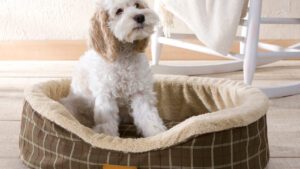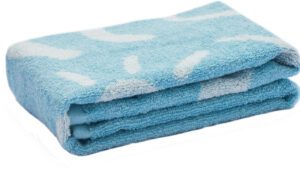Phone:
(701)814-6992
Physical address:
6296 Donnelly Plaza
Ratkeville, Bahamas.


In this article, you will learn how to wash a dog bed with stuffing, so that you can keep your furry friend’s bed clean and fresh. Cleaning a dog bed with stuffing may seem like a daunting task, but with the right approach, it can be quite simple and straightforward. By following a few easy steps, you can ensure that your dog’s bed stays free from dirt, odors, and harmful bacteria.


To start, you will need to gather the necessary supplies, such as a mild laundry detergent, a vacuum cleaner, and a washing machine. First, remove the cover from the bed and vacuum any loose dirt or hair. Next, check the care instructions on the cover to determine if it can be machine washed. If it can, simply place it in the washing machine and add the detergent.
If not, spot clean any stains using a damp cloth and mild detergent. Then, proceed to wash the cover by itself or together with other small items like blankets or towels. Once the cover is clean, dry it thoroughly before putting it back on the dog bed. Finally, give the stuffing a refresh by sprinkling some baking soda on it, letting it sit for a few minutes, and vacuuming it to remove any odors. With these simple steps, you can easily wash your dog’s bed and provide them with a clean and comfortable sleeping area.
Table of Contents
The first step in washing your dog bed with stuffing is to start by removing the cover. Most dog beds come with a removable cover that can be easily taken off for cleaning. This is important as it allows you to thoroughly clean both the cover and the stuffing inside the bed.
Before you start washing your dog bed, it is important to check the care instructions provided by the manufacturer. Different materials and fabrics may require different washing methods and specific care instructions. Make sure to follow these instructions to ensure that you do not damage the bed or the stuffing inside.
Once the cover is removed, take the time to remove any loose debris or dirt from the bed. You can do this by gently shaking the bed or using a vacuum cleaner to suck up any loose hair or particles. By removing these loose debris, you will prepare the bed for a more thorough cleaning.
After removing loose debris, it’s important to identify any stains on the bed. Common stains on dog beds can include urine, feces, mud, or food stains. Take note of the type and location of the stains so that you can treat them properly during the washing process.
To spot clean the stains on your dog bed, use a gentle stain remover specifically formulated for pet stains. Apply the stain remover on the affected areas and let it sit for a few minutes to allow it to penetrate the stain. Be sure to follow the instructions on the product label and use a cleaner that is safe for the fabric of the dog bed.
After letting the stain remover sit, gently blot the stained area with a clean cloth or paper towel. Avoid rubbing or scrubbing the stain, as this can push it deeper into the fabric and make it more difficult to remove. Continue blotting until the stain starts to fade or is completely removed.
If the care instructions allow for it, machine washing can be an effective way to clean your dog bed with stuffing. Start by choosing the right detergent for the job. Opt for a mild, pet-safe detergent that is free from harsh chemicals and fragrances. This will help to ensure the safety and comfort of your furry friend.
Once you have the appropriate detergent, set up your washing machine. Make sure to remove any other items from the machine to avoid cross-contamination. It is also recommended to use a large-capacity washing machine, as this will allow the bed to move freely and receive a thorough cleaning.
Place the dog bed in the washing machine and add the appropriate amount of detergent according to the manufacturer’s instructions. Avoid overloading the machine, as this can prevent the bed from getting properly cleaned. Start the washing cycle on a gentle or delicate setting to prevent damage to the bed or the stuffing inside.
Once the bed has been washed, it is important to choose the right drying method. Avoid using high heat settings, as this can shrink or damage the fabric and stuffing. Instead, opt for a low heat setting or an air-drying method to allow the bed to dry slowly and evenly.
If you choose to use a drying machine, set it on a low heat setting. This will help prevent any damage to the fabric and stuffing. Let the bed dry completely, checking periodically to ensure that it is not overheating or getting damaged.
To ensure that the bed is completely dry, check for any dampness or moisture. If the bed feels even slightly damp, consider air drying it to avoid any potential mold or mildew growth. Properly drying the bed is crucial for maintaining its cleanliness and preventing any musty odors from developing.
For dog beds that cannot be machine washed, hand washing is a recommended alternative. Start by filling a basin or large container with warm water. The water should be lukewarm, as hot water can shrink or damage certain fabrics.
Add a mild detergent specifically formulated for hand washing or a pet-safe detergent to the warm water. Mix the detergent in the water until it forms a soapy solution. This will help clean and remove any stubborn stains from the bed.
Place the dog bed in the soapy water solution and gently agitate it to ensure that all areas of the bed are properly cleaned. Use your hands to rub and massage the bed, paying extra attention to any stained areas or spots that require additional cleaning.
Once the bed has been properly cleaned, drain the soapy water from the basin. Make sure to remove all the soapy residue from the bed to prevent any skin irritation for your furry friend.
After draining the soapy water, refill the basin or container with clean water. The water should be at a similar temperature to the initial wash water, lukewarm and comfortable to the touch.
Place the dog bed back in the clean water and agitate it gently to ensure that all traces of soap are removed from the fabric. Continue rinsing until the water runs clear and there are no more soap suds present.
After rinsing the bed, gently squeeze out any excess water. Avoid wringing or twisting the bed, as this can damage the fabric and stuffing. Instead, press on the bed to remove as much water as possible.
Place a clean towel on a flat surface and lay the bed flat on top of it. Roll the towel with the bed inside to help absorb the remaining moisture. You can also apply gentle pressure on the towel to further remove excess water.


Finally, unroll the towel and gently fluff the bed to restore its shape. Place the bed in a well-ventilated area and allow it to air dry completely. This may take several hours or even a full day, depending on the thickness of the stuffing and the humidity in the environment.
If there are any lingering odors on the bed after washing and drying, you can use baking soda to remove them. Lightly sprinkle baking soda on the bed and let it sit for a few hours or overnight. The baking soda will help absorb any remaining odors. Once the desired time has passed, vacuum or shake off the baking soda from the bed.
Another option to remove lingering odors is to spray the bed with a fabric freshener that is safe for pets. Make sure to choose a freshener that is specifically designed for use on fabrics and is free from chemicals that can be harmful to dogs. Be sure to follow the instructions on the freshener and allow it to dry completely.
If possible, placing the bed outside in fresh air can also help eliminate any odors. The circulation of fresh air and sunlight can naturally freshen up the bed and help remove any remaining smells. However, make sure to place the bed in a secure area to prevent it from getting dirty or wet again.


To prevent dirt, hair, and debris from accumulating on the bed, make it a regular habit to vacuum the dog bed. Use a vacuum cleaner with a brush attachment to thoroughly remove any loose particles and to keep the bed clean and fresh.
Consider using washable covers for your dog bed. These covers can be easily removed and washed separately from the bed itself. Having a washable cover makes cleaning the bed much easier and allows you to maintain the cleanliness of the bed on a regular basis.
To provide additional protection for the dog bed, consider using a waterproof liner or protector underneath the cover. This extra layer can help prevent any liquids or accidents from seeping into the stuffing and causing stains or unpleasant odors.
Properly washing your dog bed is essential for maintaining cleanliness and the well-being of your furry friend. By following the steps outlined in this guide, you can ensure that your dog’s bed remains clean, comfortable, and free from odors and stains. Remember to always check the care instructions and choose the appropriate washing method for your dog bed. With regular maintenance and proper care, your dog’s bed will provide a cozy and clean spot for them to rest and sleep. So, roll up your sleeves, grab your pet-friendly detergent, and start washing that dog bed! Your furry friend will thank you for a fresh and clean place to sleep.
Learn Why Is My Dog A Light Sleeper